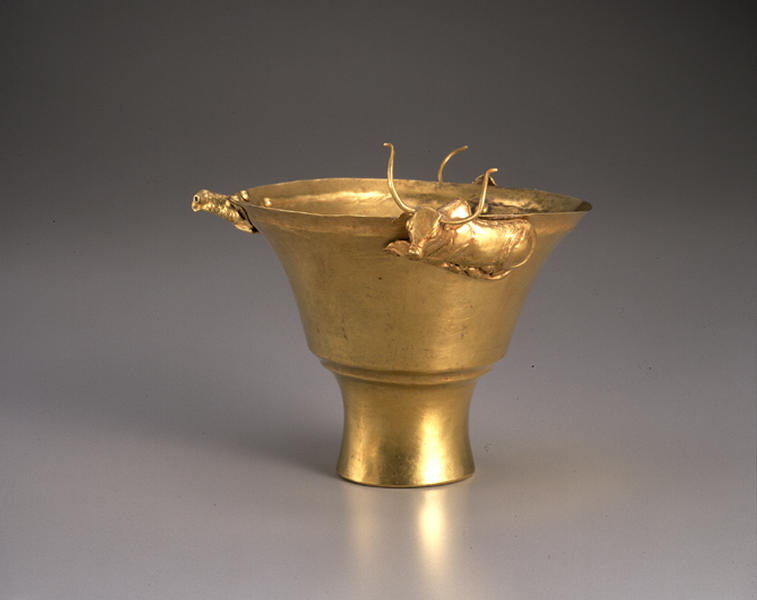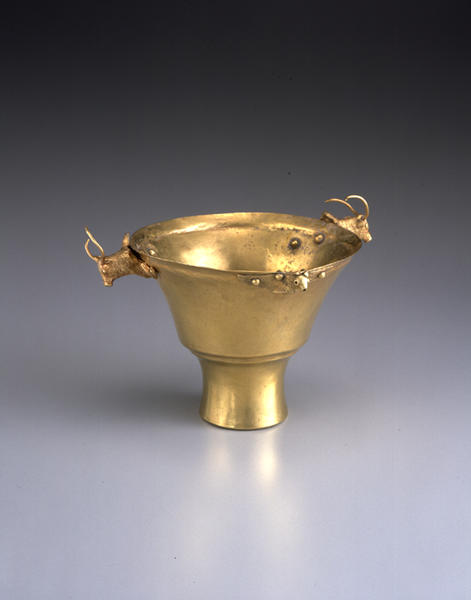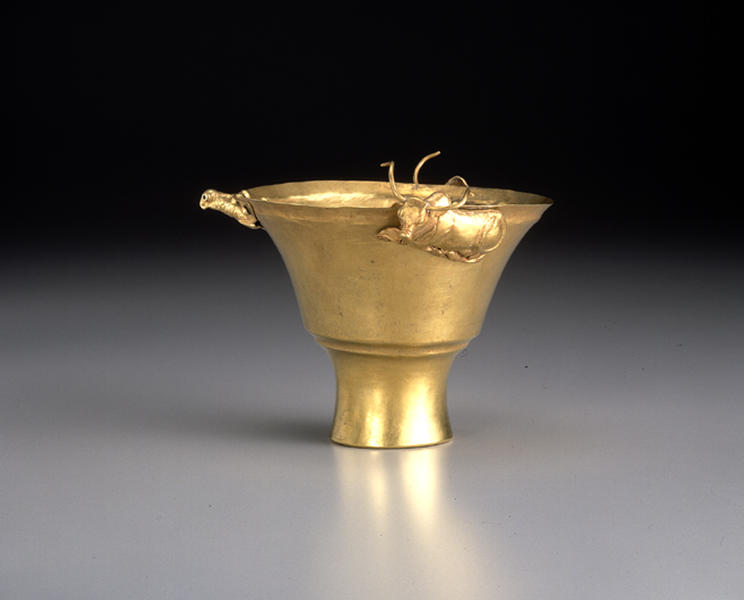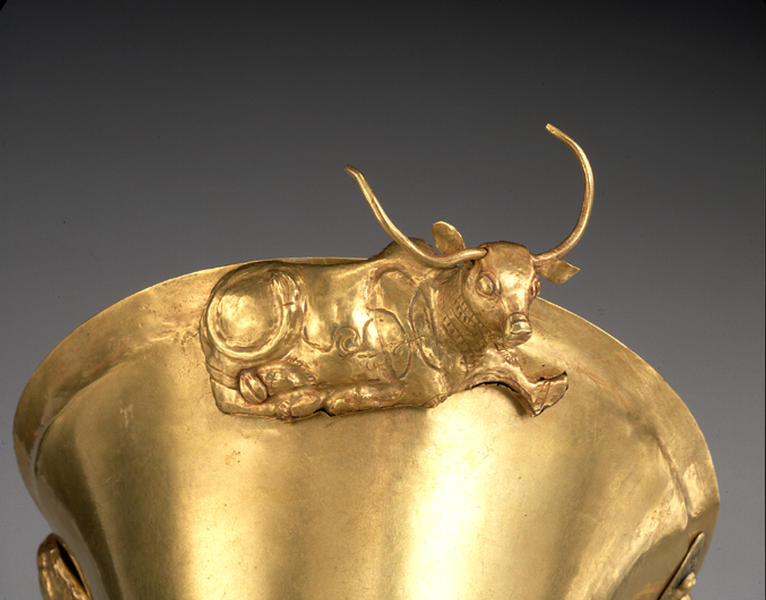猛禽牡牛装飾杯
- 北アフガニスタン
- 紀元前3千年紀末-紀元前2千年紀初期
- エレクトラム
- H-9.5 D-12
解説(開館1周年記念展)
屈曲部と滑らかな輪郭をもつエレクトラム(金と銀の天然の合金)製あるいは銀製の台付杯は,バクトリアの青銅器文化のものと考えられ,「フッロル遺宝」の銀製杯や,中央アジア西部のさまざまな遺跡で発見された同じような形の土器と比較対照されてきた。この杯の本体は屈曲部によって杯部と脚部に分けられるが,一塊のエレクトラムから叩き出されたものである。外に広がる口縁部には,翼を広げた1羽の猛禽と,それをはさんで互いに向き合って横たわる2頭の牡牛が取り付けられている。
鳥の脚は胸の方に持ち上げられ,その下方には先端を切り取られた尾が見える。このように翼を広げ,脚を胸の方に持ち上げる猛禽類の姿勢はイランの美術において極めて長い歴史をもっている。*1 頚,胸,翼には羽毛の文様が刻まれ,両翼と頚の両側には,容器の内外から円形の頭をもつ4個のリベットが付けられており,鳥を固定している。2頭の牡牛は,高浮彫になるように打ち出された後,平らな金属薄片によって裏打ちされた。この金属薄片は,牛の縁に被さるように折り曲げられている。また,牡牛を固定するための円頭リベットがおのおの2個ずつ容器の内側に残っている。牛の胴体はリベットの位置に従って斜めに置かれ,頭部は胴体に半横向きについている。牛の脚は胴の下で折り曲げられ,性器が後脚の間にはっきりと示されている。また両方の牛の■円形の目,鼻,口の細部,前脚と臀部の筋肉組織,頚の線影を付けられた部分,胴部に水平に配置されたS字状の渦巻き,これらはすべて刻線で表現されている。
口縁部の付属物というのは極めて稀であるが,メトロポリタン美術館蔵のエレクトラム製台付杯とは比較対照することができる。*2 現在この杯に取り付けられている鳥と牡牛は,容器の輪郭と完全に一致しているわけではないが,古代に作られたと考えられるリベットが内部に付いていることから,古代のある時期に取り付けられたものと推測できる。
1 Holly Pittman/Art of the Bronze Age : Southeastern Iran, Western Central Asia, and the Indus Valley/New York 1984
2 Holly Pittman/1984 ibid.
参考文献(Bibliography):Joan Aruz/作品解説 no.7 (Ancient Art from the Shumei Family Collection/New York 1996)
Catalogue Entry
Electrum and silver goblets which have a carinated and smooth profile are thought to be from Bronze Age Bactrian culture. They are paralleled by silver vessels of the "Fullol hoard" and similarly shaped pottery excavated at various sites in western Central Asia. The vessel is hammered out of one piece of metal, of which the main part is divided by carination into the cup and the foot. On the wide rim, there are attached a vulture with outspread wings, and two reclining bulls facing out on opposite sides of the goblet.
The legs of the bird are held up to its chest, and the truncated tail is visible below. The posture of the vulture, with wings spread and legs tucked under its body, has an extremely long history in Iranian art.*1 The bird has feather patterns incised on the neck, chest, and wings. It is fixed with four round-headed rivets, two on each side of the neck and wings, visible from both inside and outside the vessel. Two bulls were hammered in high relief over a core, and then backed by a flat sheet of metal that was folded over the edge. Two round-headed rivets for each bull can be seen on the inside of the cup. The bodies of the bulls are attached obliquely according to the placement of the rivets, and the heads are at a three-quarter angle to the body. The limbs are bent beneath the bulls, and the sexual organs are prominently displayed between the hindlegs. Details of the oval eyes, the nose and mouths, the musculature of the foreleg and rump areas, hatched bands on the neck, and the horizontally placed S-spirals on the belly of each animal have been incised.
There are very few examples of goblets with rim attachments; the only other comparable example is an electrum goblet in the Metropolitan Museum.*2 Although the bird and bulls do not perfectly fit the contours of the goblet, the presence of rivets on the inside, which appear to be of ancient manufacture, suggests that they were attached at some period in antiquity.



